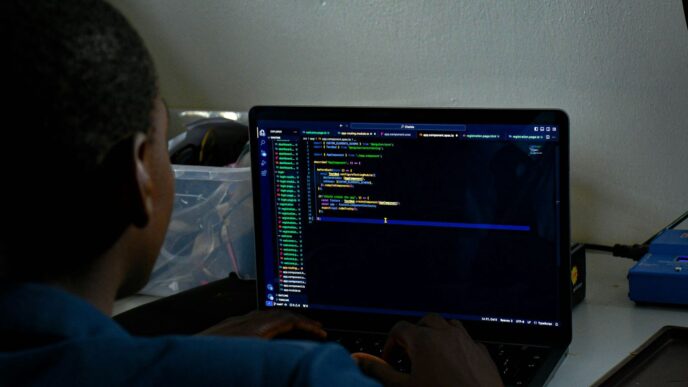Learning Python on your Android device is totally doable these days. Gone are the days when you needed a full computer setup. Whether you’re just starting out or want to code on the go, there are some solid python coding app for android options out there. We’ll look at a few that stand out, covering everything from simple editors to more complex IDEs that let you build actual apps.
Key Takeaways
- Pydroid 3 is a feature-rich IDE for Android, offering an offline interpreter, package management, and built-in compilers, making it great for learning and development.
- Acode serves as a capable code editor with Python syntax highlighting and auto-fill, but often requires Termux to actually run Python code.
- Termux provides a Linux-like environment on Android, allowing you to install and run Python directly, making it a powerful tool when paired with a code editor.
- Tools like Briefcase, Buildozer, Chaquopy, and PyQtDeploy are designed to help developers package Python code into native Android applications, rather than just running scripts.
- While PyCharm is a popular desktop IDE, it’s not directly a python coding app for Android in the same way as the others; its mobile presence is more about remote development or specific integrations.
Pydroid 3
If you’re looking for a Python IDE that’s pretty straightforward to use on your Android device, Pydroid 3 is a solid choice. It’s designed to be an educational tool, meaning it tries to make learning Python a bit easier. One of the best things about it is that you don’t need an internet connection to run your Python code, which is handy when you’re out and about or have spotty Wi-Fi. It comes with a package manager, pip, and even has a special repository for pre-built scientific libraries like NumPy and SciPy. This means you can often install these powerful tools without a lot of hassle.
Pydroid 3 also includes a built-in compiler for C, C++, and Fortran. This is a big deal because it allows the app to build libraries from pip that use native code, something that can be tricky on mobile. You get features like code prediction, auto-indentation, and real-time code analysis, which are pretty standard in desktop IDEs but nice to have on a phone. There’s also a debugger with breakpoints and watches to help you find and fix errors in your code. For graphical interfaces, it supports Tkinter and Kivy, and even has support for libraries like OpenCV, TensorFlow, and PyTorch, though some of these might require a premium version.
Here’s a quick rundown of some key features:
- Offline Python 3 interpreter: Run your code anywhere.
- Pip package manager: Easily install third-party libraries.
- Built-in compilers: Supports C, C++, and Fortran for building native libraries.
- Code editor features: Includes syntax highlighting, auto-indentation, and code prediction.
- Debugging tools: Breakpoints and watches to help troubleshoot.
- GUI library support: Tkinter, Kivy, and others.
While most features are free, some advanced libraries or specific functionalities might be part of the premium version. This is often because porting those libraries can be quite complex and requires extra development effort.
Acode
Acode is a pretty solid code editor for Android that you can grab from the Play Store. It’s got some nice features for Python development, like syntax highlighting, which makes reading your code a lot easier. It also offers auto-fill, helping you type less and make fewer mistakes. I’ve found it to be a good option for writing Python scripts right on my phone.
One thing to note is that the free version doesn’t include dark mode. If you’re like me and prefer a darker interface, especially when coding late, you’ll need to purchase the app to enable it. It’s a small price to pay to support the developer, though.
Now, Acode itself is an editor, meaning it helps you write code. To actually run that Python code you’ve written, you’ll need another app. The most common recommendation is Termux. So, while Acode is great for the writing part, you’ll want to pair it with something like Termux to get your Python scripts executing on your Android device.
Termux
Termux is a bit different from the other apps on this list. It’s not a dedicated Python IDE, but rather a powerful terminal emulator that lets you run a Linux-like environment right on your Android device. Think of it as a command-line interface for your phone. This means you can install Python and other development tools directly within Termux.
To get Python set up, you’ll usually need to run a command like pkg install python. Once Python is installed, you can start writing and running your scripts. You can navigate to your project folders using standard Linux commands like cd. For example, if your Python files are in a folder named ‘my_python_projects’ inside your device’s storage, you might type cd storage/shared/my_python_projects to get there. Then, to run a script named ‘hello.py’, you’d simply type python hello.py.
Termux is great if you’re comfortable with the command line and want a flexible environment. It doesn’t come with a fancy graphical editor built-in, so many people pair it with a separate text editor app like Acode. You write your code in the editor, save it, and then use Termux to run it. It’s a bit more hands-on, but it gives you a lot of control.
Here’s a quick rundown of what makes Termux useful:
- Command-line power: Access a full Linux command-line environment on your phone.
- Package management: Use
pkgto install Python and other useful tools. - Flexibility: Works well with other text editor apps for a complete workflow.
- No rooting required: You can use its full capabilities without modifying your device’s system.
Pythonista
Pythonista is a pretty neat development environment that lets you write and run Python scripts right on your iPhone or iPad. It’s not just for simple scripts either; you can work with third-party libraries and even interact with your device’s system features. Think of it as a mini-IDE that fits in your pocket.
One of the cool things about Pythonista is its focus on making Python development on iOS feel natural. It comes with a bunch of built-in modules that give you access to things like the UI, storage, and even some hardware features. This means you can build some pretty sophisticated apps without needing a desktop computer.
Here’s a quick look at what makes it stand out:
- Integrated Development Environment: It provides a full-featured editor with syntax highlighting, code completion, and a debugger. You can also manage your projects and files easily within the app.
- Extensive Libraries: Beyond the standard Python library, Pythonista includes modules for graphics, networking, and interacting with iOS features. This really helps in creating more complex applications.
- Scripting Capabilities: You can automate tasks, process data, or even build simple graphical interfaces using its built-in UI elements. It’s a great way to learn Python on the go.
While it’s designed for iOS, it’s a solid choice if you want a dedicated Python environment on your Apple mobile devices. It’s a bit different from the Android-focused apps, but it offers a powerful experience for iOS users.
Pyto

Pyto is another solid choice if you’re looking to code Python on your iPad or iPhone. It’s designed to be a full development environment, meaning you get a lot of tools right out of the box. Think of it as a mini-IDE that lives on your mobile device.
What’s cool about Pyto is how it handles libraries. It comes with many popular ones already built-in, and it also supports system integration, which is pretty neat for mobile development. You can even work with things like NumPy, Pandas, and Matplotlib without a huge hassle.
Here’s a quick rundown of what makes Pyto stand out:
- Built-in Libraries: Access to common Python libraries without needing to install them separately.
- System Integration: Connect your Python scripts to iOS features.
- GUI Support: Tools for creating graphical interfaces on your device.
- Package Management: It has ways to install additional packages you might need.
Pyto really shines when you want to run Python scripts that interact with your device’s capabilities. It’s not just about writing code; it’s about making that code do things on your iPhone or iPad. While it might have a bit of a learning curve compared to simpler apps, the power it offers for mobile Python development is pretty impressive.
Briefcase
Briefcase is a tool from the BeeWare project that helps you package your Python code into native applications for various platforms, including iOS and Android. Think of it as a way to take your Python scripts and turn them into something that can be installed and run like any other app on a phone or tablet. It’s designed to make the process of deploying Python applications outside of a typical desktop environment a bit more straightforward.
It’s particularly useful when you want to distribute your Python projects as standalone apps.
Here’s a simplified look at what Briefcase helps you do:
- Package your Python code: It takes your Python scripts and any dependencies you’re using.
- Create native app structures: It generates the necessary project files and directory layouts for the target platform (like iOS or Android).
- Build the final application: It assists in compiling your Python code and packaging it into an installable app format.
While it’s not an IDE in the traditional sense where you write code directly within it on your phone, Briefcase is a vital part of the workflow for getting Python applications onto mobile devices.
Buildozer
Buildozer is a tool that comes from the Kivy project, and it’s designed to help you package your Python applications for different platforms, including Android. Think of it as a way to take your Python code and turn it into a standalone app that can run on a phone or tablet. It handles a lot of the tricky setup that you’d otherwise have to do manually.
It’s particularly useful if you’re already working with Kivy for your UI, but it can be used for other Python projects too.
Here’s a general idea of how it works:
- Configuration: You’ll typically create a
buildozer.specfile. This file tells Buildozer about your project, like its name, version, and any special requirements. - Dependencies: Buildozer figures out what Python libraries your app needs and tries to include them in the final package.
- Compilation: It compiles your Python code and any necessary native extensions into a format that Android can understand.
- Packaging: Finally, it bundles everything up into an Android package (APK) or iOS package (IPA).
While it simplifies the process, there’s still a learning curve. You’ll need to get comfortable with its configuration file and understand how it interacts with your project’s dependencies. It’s a powerful tool for getting your Python projects onto mobile devices, but it’s not quite as simple as just hitting a ‘build’ button without any prior setup.
Chaquopy
Chaquopy is a bit different from the other apps we’ve looked at. Instead of being a standalone IDE you use directly on your phone, it’s more of a plugin for Android Studio. This means you’re primarily developing your Python code on a desktop or laptop, and Chaquopy helps you integrate that Python code into your Android applications.
It’s a powerful tool for developers who want to leverage Python’s extensive libraries within native Android apps. Think of it as a bridge, allowing your Java or Kotlin Android code to talk to your Python scripts. This is super handy if you’re working on something that needs heavy data processing, machine learning, or scientific computing, and you’d rather use Python’s mature ecosystem for those tasks.
Here’s a quick rundown of what it offers:
- Python Integration: Easily embed Python 3 into your Android projects.
- Library Support: Access a wide range of Python libraries, including popular ones like NumPy and SciPy, directly within your Android app.
- Performance: Designed to be efficient, so your Python code doesn’t bog down your app.
- Build System: Works with Gradle, the standard build tool for Android, making integration smoother.
While it’s not an app you’d open on your phone to just write a quick script, Chaquopy is a serious contender if you’re building full-fledged Android applications that benefit from Python’s capabilities.
PyQtDeploy
So, you’ve got a PyQt project and you’re thinking, ‘How do I get this onto my phone?’ That’s where PyQtDeploy comes in. It’s a tool specifically designed to take your Python code, especially if it’s using the PyQt framework, and package it up so it can run as a native app on mobile devices like Android and iOS.
Think of it as a bridge. On a desktop, Python is pretty straightforward to install and run. But on Android, it’s different. You can’t just install Python like you would on a PC. Instead, Python has to be embedded within a native app. PyQtDeploy helps you do just that. It handles the tricky bits of bundling your Python interpreter, your code, and all the necessary libraries into a single package that the mobile operating system can understand.
Here’s a general idea of how it works:
- Packaging your code: PyQtDeploy takes your Python scripts and any PyQt-related files.
- Bundling dependencies: It makes sure all the libraries your app needs are included.
- Creating a deployable app: It then compiles this into something that can be installed on your phone.
This approach means your Python application can feel more like a native app, rather than something running in a separate environment. It’s a way to bring your desktop Python GUI applications to the mobile world without starting completely from scratch. If you’re looking to deploy PyQt applications to mobile, PyQtDeploy is definitely a tool worth checking out for packaging your Python code.
PyCharm
Okay, so PyCharm is a bit of a different beast compared to the other apps we’ve talked about. It’s a full-blown Integrated Development Environment (IDE) made by JetBrains, and while it can be used on Android, it’s not really a mobile-first app like Pydroid 3 or Acode. Think of it more like bringing a desktop-class experience to your phone or tablet.
The main draw here is its powerful features, which are usually found on a desktop. This includes things like smart code completion, debugging tools, version control integration (like Git), and a really robust refactoring system. It’s the kind of tool that serious Python developers use on their computers, and JetBrains has made an effort to bring that power to mobile.
However, using PyCharm on Android isn’t as straightforward as just downloading an app from the Play Store and running it. It often involves setting up a remote interpreter or using a specific version designed for remote development. This means you’re typically connecting to a development environment running elsewhere, like your PC or a server.
Here’s a quick rundown of what that might look like:
- Remote Development: You install PyCharm on your computer and then connect to your Android device to run and debug code. This is probably the most common way to use its advanced features on mobile.
- Server-Side Execution: You might set up a Python environment on a server and use PyCharm on your Android device to write and manage that code.
- Limited Standalone Use: There might be ways to run a more basic version directly on Android, but it’s not its primary focus and might feel clunky compared to its desktop counterpart.
So, if you’re already a PyCharm user on your desktop and need to do some coding on the go, it’s definitely an option. But if you’re looking for a simple, self-contained Python IDE to just pick up and use on your phone, you might find the other options we’ve covered a bit more user-friendly.
Wrapping Up Your Mobile Python Journey
So, there you have it. Coding Python on your Android device isn’t some far-off dream anymore. With apps like Pydroid 3 and Acode, paired with tools like Termux, you’ve got a pretty solid setup right in your pocket. It might take a little getting used to, and sure, it’s not the same as a full desktop setup, but for learning, tinkering, or even getting some work done on the go, these options are surprisingly capable. Don’t let the small screen fool you; your next Python project could be just a tap away. Give them a try and see where your mobile coding adventures take you.
Frequently Asked Questions
What’s the best app for learning Python on an Android phone?
Pydroid 3 is often considered the best for learning because it’s like a mini-computer for Python. It works offline, has tools to help you install extra libraries easily, and even includes a built-in compiler. It’s designed to make learning Python on your phone smooth and straightforward.
Can I code Python without an internet connection on my phone?
Yes, many apps like Pydroid 3 let you code and run Python programs completely offline. This means you can practice your coding skills anywhere, even without Wi-Fi or mobile data.
What is Termux and why do I need it?
Termux is like a powerful command line for your Android device. It creates a mini Linux environment on your phone, allowing you to install and run Python and other tools. Some code editors, like Acode, need Termux to actually run the Python code you write in them.
Are there apps that let me build actual Android apps with Python?
Yes, tools like Briefcase, Buildozer, Chaquopy, and PyQtDeploy help you package your Python code into Android applications. This is a more advanced step, allowing you to create real apps that can be installed on other devices.
What’s the difference between a code editor and an IDE on Android?
A code editor, like Acode, is great for writing and organizing your code. An IDE (Integrated Development Environment), like Pydroid 3, is more like a complete workshop. It includes an editor, a way to run your code, tools to debug it, and often helps with installing extra libraries, all in one place.
Do I have to pay to use these Python apps?
Many apps offer a free version that’s great for getting started. Some, like Pydroid 3, have a premium version with extra features, often for things that were difficult to add. Others, like Acode, might offer features like dark mode only in the paid version. You can usually try them out for free to see if they fit your needs.














